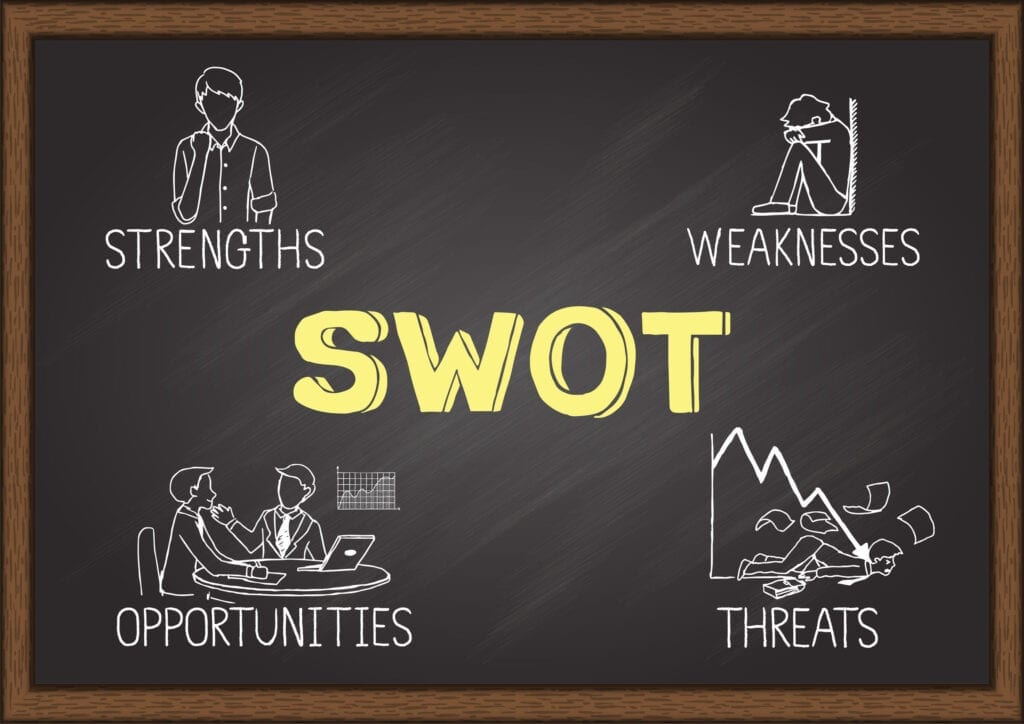The Journey, Part 4: Personal SWOT Analysis
By this point in your journey, you are clear on the fundamentals, where you’re heading, your Vision, Mission, and Objectives. You understand how you’ll achieve your personal goals. You still have concerns about how you’ll deal with all the variables in your Business Model outside of your comfort zone.
It’s time to do a Personal SWOT analysis.
Contents
Steps in Creating Your Personal SWOT
This exercise will be an eye-opener. How are you going to build a team that can execute? Please understand that this is NOT the SWOT analysis you’ll be doing later in the process while formulating your Business Plan.
- Print your objectives and business goals and have them in front of you. Pick the most important ones from each list.
- Focus on the near term: one year out rather than your intended endgame. If you don’t get past the first year, everything else is meaningless.
- List your Strengths, Weaknesses, Opportunities, and Threats as they relate to your objectives and near-term business goals. Don’t worry about the order of priority; just get them on paper.
For your first iteration, use this order: Opportunities, Strengths, Threats, and Weaknesses. Focus on one section at a time and list your thoughts. I’ve listed a few common ones to help you get started.
Opportunities
- I can solve a significant problem for a large number of people.
- Monetizing my solution can provide a good life for my family.
- I’ll make a name for myself.
- I’ll be able to give back to society.
- My Twitter following will grow exponentially.
Strengths
- I’ve personally struggled with the problem, so I understand it well.
- My work experience is relevant to my solution.
- I’m an excellent communicator.
- I’ve always found a way to succeed in my previous jobs.
- I work well under pressure.
- I know how to assemble a team and manage it effectively.
- I’m a good negotiator.
- I don’t give up.
- I get things done.
- I played high school football.
Threats
- I may not have the financial staying power required.
- I might not convince the right people to join the company.
- The current business environment might limit my ability to gain customers.
- Regulatory changes could severely impact my program.
- I’m in Winnemucca, Nevada – It might be hard to convince people to relocate.
Weaknesses
- I’m not a technical person, but my solutions are technically complex.
- I tend to give up when I’m overwhelmed.
- Most of the functions identified in the Business Model are out of my comfort zone.
- I’m not the best communicator.
- I don’t handle pressure well.
- I’m out of money.
- I’m only in this for the money.
- I suck at golf.
Analyze the Results
Did you end up with long lists under weaknesses and threats, and short lists under strengths and opportunities? If you developed a viable Business Model around your solution, don’t be so pessimistic. However, If you were completely honest with yourself, get on the phone to get that day job back.
Perhaps you have a long list of strengths, and opportunities, minimal threats, and few, if any, weaknesses. You are in denial at a critical stage of your venture’s development.
Maybe you don’t know yourself as well as you think. A business coach, mentor, or trusted business associate can help you see more clearly.
Revisit your conclusions in a couple of days.
Assume you could attract the right team and cross off the items that don’t negatively impact your ability to reach your goals.
- Your task is to assemble the team to cover the weaknesses, mitigate the threats, and act on the opportunities. Don’t overthink it, be aggressive and pare down the list. Doing so will allow you to crystalize your hiring objectives.
- Attack the remaining weaknesses. Are they relevant, or merely fears? If they are relevant, decide what it will take to turn them into strengths. Covering your weaknesses will mainly be done by renting or hiring talent with the needed skills and letting them perform.
- Review the threats and see what you can do to mitigate them. If you’re concerned, you won’t attract the right people to join you – understand why. Maybe you lack confidence, or you’re unable to articulate the fundamentals with conviction. Work on those aspects until you can. I can’t overstate how critical communication will be for you going forward. If you’re in Winnemucca, plan to move.
- Review the strengths. Are they relevant to your goals and business model? Cross off the ones that aren’t and add the ones that surfaced during your review. Be sure to add communication skills as soon as you have the confidence to do so. Consider it priority one.
Obtain meaningful and honest feedback from your coach, mentor, or a trusted businessperson. If done well, you’ll have a clear understanding of what’s needed, and you’ll be more confident—dust off the list related to not attracting the right talent. You want a team that can cover all the bases and executes your plan. That college buddy you thought would be perfect might not be what you need.
Revisit this analysis periodically as you move forward. You’ll know you’re on the right track if your actions allow you to delete weaknesses and reduce threats.
Up Next
The founder’s action plan. With your Business Model in hand, coupled with a realistic Personal SWOT analysis, you’re ready to start developing your Founder’s Action Plan. From here on, things get more comfortable because you’re clear on what is needed. You’re on the verge of the only thing that ultimately matters – execution.

